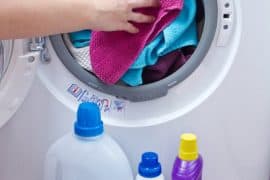Rayon is a textile material that has been used for many years, and it’s a great alternative to cotton. It has a soft feel and dyes well, but there is one downside – the harmful chemicals that have to be used during processing.
The most common rayon production process includes using carbon disulfide or hydrogen sulfide gas as intermediates in the reaction of cellulose with acetic acid (Webster). Both of these chemicals are known carcinogens, which means they can cause cancer.
Lyocell is another form of rayon that doesn’t use those harmful chemicals (and although it may seem like lyocell is simply another term for rayon, it technically isn’t), so clothing made from this fiber is much safer and environmentally friendly.
The name for lyocell is “Tencel”, which is the brand name of the material, but many people have been using the terms “lyocell” and “Tencel” interchangeably lately.
Lyocell uses wood pulp as a starting material instead of cellulose, so it’s still a type of rayon – but with one big difference – fewer chemicals are used in processing!
Depending on the manufacturing process being used, fewer chemicals may mean none at all (synthetic). In fact, during a recent test done by an independent laboratory, only sodium hydroxide was found to be used in the production of Tencel from raw materials to the finished product (Baxter).
The ability to use natural, sustainable resources is one of the greatest benefits of lyocell. Every step in the production process can be carried out using an environmentally friendly method, so there’s no need to worry about harmful chemicals being used.
Another great benefit of this textile material is that it doesn’t shrink or pill, which means clothing made from it lasts much longer than cotton items do.
As anyone who has ever owned a cotton shirt knows, after washing and drying it just once, pilling starts to appear all over the fabric.
This kind of damage occurs because people are overexposing their clothes to water! Instead of throwing away t-shirts after only a few years because they’ve become pilled and worn out, lyocell items can be used for much longer.
The natural fibers in this fabric are also more breathable than cotton, so people won’t get as sweaty while wearing it. This is especially important during the summer months.
Lyocell clothing is available in many styles these days, including socks, activewear, underwear, sweaters, jeans, and skirts! Because of its softness and ability to keep its shape better than other fabrics do, more clothing designers are choosing it over cotton to make modern fashion items.
Advantages of using Lyocell for your clothing brand:
-Doesn’t shrink or pill
-Breathable and natural fibers
-Environmentally-friendly production process
-Soft feel to clothing Disadvantages
Lyocell vs. Viscose vs Rayon
In terms of how it’s made, lyocell is very similar to viscose and rayon.
All three fabrics are created from a plant cellulose base that has been turned into a fiber, but there are differences related to the manufacturing processes. Lyocell uses wood pulp as a starting point instead of cotton or other natural fibers, so it’s easier to manufacture without any harsh chemicals (Bullet).
This makes it an environmentally friendly product! In general, lyocell is more resistant to wrinkles than viscose or rayon due to its unique properties. Lyocell’s production process also creates a stronger textile material with better traceability.
This makes clothes made from this fabric last longer without becoming damaged or worn out. When it comes to lyocell vs. viscose, the only real difference is that viscose is a cheaper material in general. Lyocell’s higher price tag reflects its benefits and advantages when compared with other fabrics!
Lyocell vs Cotton
Cotton is a natural fabric made from the seeds of a cotton plant, while lyocell is made from wood pulp. This means that cotton requires chemicals during the manufacturing process, much like how rayon does (Bullet).
The chemicals used in production help make cotton soft but also add toxicity to the fabric when burned or washed over time (Toxipedia). Lyocell has none of these harmful attributes, so it’s definitely a much safer alternative for people who want to make sure the materials they wear are safe.
Instead of cotton, people who want softness but don’t want to have to worry about chemicals should consider Lyocell!
Lyocell vs Nylon/Spandex
When it comes to durability, lyocell is similar to nylon and spandex. All three fabrics are very strong compared with natural fibers like cotton or wool.
Lyocell doesn’t require harsh manufacturing processes though, so there’s less reason for concern when it’s being worn against the skin.
The use of wood pulp instead of cellulose also makes lyocell easier to recycle than other synthetic fibers (Toxipedia). These reasons contribute to why more clothing designers are choosing this fabric over others because it’s versatile and sustainable.
As you can see, lyocell is better than cotton in many ways! It’s more resistant to wrinkles and softer against the skin, plus it doesn’t contain any harmful chemicals or toxic substances like cotton does.
Is Lyocell Sustainable?
Yes, lyocell production is a sustainable process. Manufacturing lyocell doesn’t require any chemicals that have to be manufactured and then used in the textile’s manufacturing process, so there are no environmental concerns associated with producing this material.
Lyocell uses wood pulp as a starting point instead of cotton or other natural fibers, but trees are still grown for this purpose (Baxter). As long as tree farms are managed well, there should be enough trees growing to produce lyocell indefinitely.
What can Lyocell be Used For?
Lyocell is used in clothing, sheets, and many other home materials. It’s also used to make nonwoven fabrics like diapers.
One of the most common uses for lyocell is to make underwear fabric! T-shirts are another popular item that this textile material can be found in; it gives them their soft feel while keeping them breathable.
People who want stylish clothes that don’t wrinkle easily should consider buying items made from this fabric.
There are even special types of lyocell that offer water resistance (Bullet). When natural fibers are combined with the moisture-wicking capabilities offered by synthetics, an excellent product can be created!
Lyocell is a versatile material that doesn’t have any disadvantages when compared with cotton. It’s soft, breathable, strong, and sustainable! For all these reasons more clothing designers are choosing to use it in new fashions every day.
How to Care for Lyocell?
The ideal way to care for any lyocell item is to wash it in cold water and line dry it. Warm or hot water will shrink the material, so this should be avoided. If items are put in the dryer, they can become damaged by high heat so they should be air-dried instead (Baxter).





